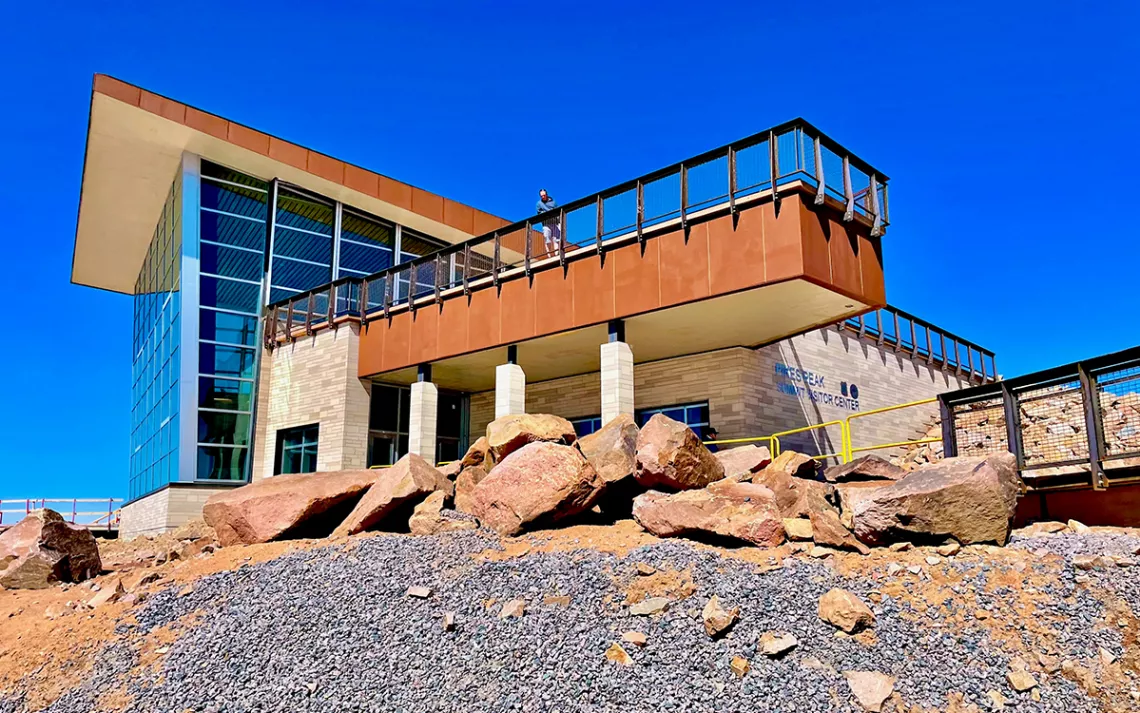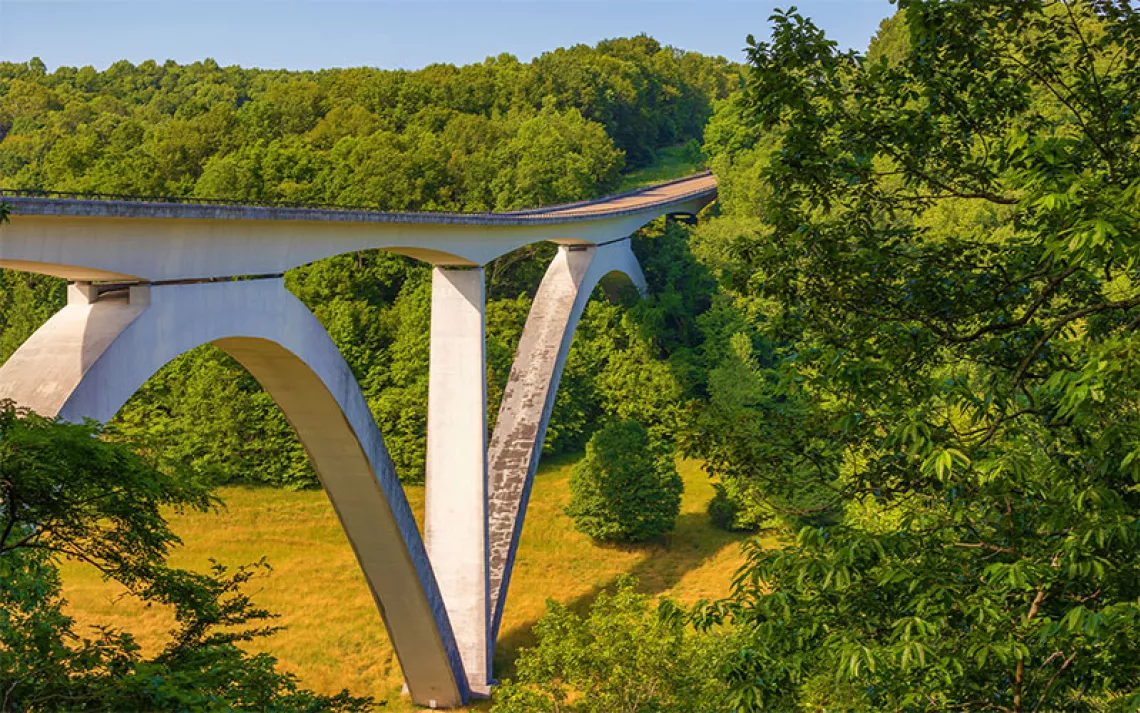Pikes Peak’s Innovative Adaptation to the West’s Water Crisis
Yes, this is a feel-good story about mountaintop bathrooms

Photo by John M. Chase/iStock
Colorado’s Pikes Peak is like no other “fourteener” in the country. The summit, which overlooks the city of Colorado Springs, is a world-famous tourist attraction, featuring a fully accessible mountaintop visitor center. You can hike to the summit or drive; you can even travel by rail aboard the Broadmoor Manitou and Pikes Peak Cog Railway, which has been in operation since 1891.
Passengers on “the Cog,” warned about the effects of the “thin air” on the summit, are urged to hydrate. There are no bathrooms on board, however, so when the 300 passengers disembark, many of them head directly for the restrooms.
Given its remote location, the facilities atop Pikes Peak are not connected to the city’s water and wastewater utilities. There are no wells or septic fields, either. For as long as there has been demand, all potable water has been hauled to the peak, and all wastewater hauled back down. As visitation has expanded—Pikes Peak saw close to a million visitors in 2022—so too has the demand for water, and the burden of waste.
“During the summer months, our guys were bringing two to three truckloads of freshwater per day up to the summit,” says Sandy Elliott, manager for Pikes Peak—America’s Mountain, the entity that owns and operates the Pikes Peak Highway and Summit Visitor Center. Each year, on average, trucks were hauling 530,000 gallons of freshwater up the mountain and 670,000 gallons of wastewater off. On busy days, the trip takes two hours. The associated costs—of labor, fuel, and carbon emissions—were significant.
In June 2021, however, Pikes Peak—America’s Mountain unveiled a new Summit Visitor Center, boasting an airy lobby and wall of windows framing the magnificent view of distant mountains. When it came time to design this center and consolidate other structures on the peak, the City saw an opportunity to greatly reduce its water footprint. Now, thanks to a suite of super-efficient vacuum flush toilets and a localized system that treats blackwater to the standards of reclaimed water, those costly haul trips should be cut by more than half.
The City operates facilities on the summit under a special permit from the US Forest Service. From an aesthetic standpoint, almost any new building would have been an improvement. The old visitor center, built in 1964, was undersized and dark inside, like a bunker; for decades, jacks installed underneath the building kept it from sinking into the permafrost. Worst of all, the restroom facilities were woefully inadequate. When the Cog delivered its surge of passengers, many people spent their entire time atop the summit waiting in line. In contrast, the new Summit Visitor Center features plenty of stalls in each restroom.
These are not run-of-the-mill commodes but vacuum flush toilets, of the sort found in RVs and cruise ships. Because they rely on a powerful negative pressure to suck the contents from bowl to the waste pipe, they require a scant third of a gallon of water per flush—far less than even the most efficient flush toilet.
While visitors browse the interpretive exhibits and gaze out at the inspiring vistas from the upper two floors of the visitor center, wastewater from the toilets, waterless urinals, and kitchen grease traps is collected and funneled to the basement below. The treatment system is composed of an overwhelming but impeccably organized maze of tanks and plumbing. Some of the pipes sport bright-purple stripes and the words Reclaimed Water: Do Not Drink and arrows suggesting the direction of flow.
“One of the early discussions was, this building needs to be sustainable and maintainable,” says Elliott. In addition to reducing demand by installing super-efficient toilets, planners wanted to explore the possibility of capturing rainwater and snowmelt and of treating and reusing wastewater.
The project’s design team, which included architects from Colorado Springs–based RTA Architects and Baltimore firm GWWO Architects, realized that the City’s goals were well aligned with the Living Building Challenge, an ambitious green building standard hosted by the International Living Future Institute. The Living Building Challenge requires building projects to produce more energy than they consume, to capture all water needed for the building to function, and to treat all graywater and blackwater onsite. The challenge also includes stipulations for equity, beauty, and responsible material sourcing, among other factors.
The system is being permitted under Colorado’s Reclaimed Water Treatment Regulations.
“We are treating blackwater,” says Simon Farrell, senior project manager at JVA, Inc, which designed the treatment system. “We are taking wastewater in basically unheard-of concentrations and treating it to a reclaimed water standard and reusing it.”
Once wastewater is physically screened, it goes into “membrane bioreactor” tanks, where several processes happen at once. A submerged ultrafiltration membrane removes solid particles, while bacteria break down organic compounds. To keep the bacteria happy, the tanks must be aerated. Here, the extreme elevation presents a challenge: Air is less dense, containing less oxygen per unit of volume. To compensate, the aeration system is larger.
Water that exits the tanks appears clear but must still be disinfected. It goes through a series of UV vessels, and in the final step, is dosed with chlorine. From there, water goes to a holding tank.
The treated water isn’t consistently meeting the threshold for UV transmittance—an important metric required by the health department. To help troubleshoot this issue, Farrell and his team have brought on a third-party expert. Once the issue is resolved, the system can complete field validation, which is required before reclaimed water can be used to flush toilets.
For this reason, all of the treated water is being hauled down the mountain for now.
Behind the building is a loading zone where trucks can unload tanks of drinking water and load tanks of treated wastewater—"different trucks!” Elliott is quick to point out. The vacuum flush toilets alone have sharply reduced overall water consumption.
“We’re not anywhere close to three loads a day since the new facility opened,” says Elliott. “We might be delivering water every three days now.”
Most large cities and towns in Colorado reclaim and treat wastewater and use it to irrigate golf courses, parks, and the like. More recently, the state set guidelines for direct potable reuse—a euphemistic term for turning wastewater into drinking water.
“We’re seeing massive adoption [of water reuse] in the state, out of necessity,” says Farrell. “It’s a pretty simple equation: There’s not enough water to meet demand.”
For the same reason, states are turning to small-scale reuse, with progressive municipalities on both coasts leading the charge. The City of San Francisco, for example, requires all large new buildings to be “dual piped” and for reclaimed water to be used to flush toilets.
Before 2018, Colorado did not allow reclaimed water to be used to flush toilets. The Pikes Peak team helped lobby the state’s Water Quality Control Commission to amend its regulations; as of now, there is only one other project in the state that has such a localized reclaimed water treatment system.
“It's really hard when you have a perfectly good municipal water supply system sitting right outside your building that you can just tap into,” says Pete Jefferson, engineer at BranchPattern, which designed the conveyance system for the Pikes Peak project. “When water and wastewater is 12 or 13 times more expensive, like it is on Pikes Peak, the math works a lot better.”
If you go to Pikes Peak and fill your Hydroflask at the drinking fountain, know that you’ll be drinking water hauled up from Colorado Springs’ municipal plant. In Colorado, rainwater harvesting is not legal on any meaningful scale, although homeowners are allowed two 55-gallon barrels to capture rainwater from their roofs and use it in their home gardens and landscaping. The Pikes Peak team, which is still pursuing certification under the stringent Living Building Challenge, did make some allowances for a future rainwater harvesting system.
“We can't do it now, but can we do it in the future, and do we set ourselves up to do it in the future?” says Elliott. “For us, the answer was an overwhelming yes.”
In Colorado, where the drying trend is expected to continue, the Pikes Peak Summit Visitor Center is positioned for resilience.
 The Magazine of The Sierra Club
The Magazine of The Sierra Club



